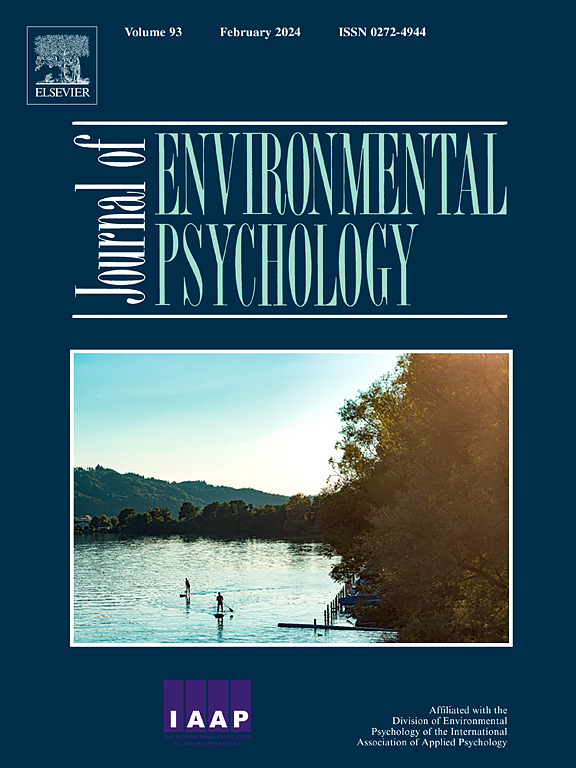Role of indoor environmental attributes on creativity: A systematic review
IF 6.1
1区 心理学
Q1 ENVIRONMENTAL STUDIES
引用次数: 0
Abstract
In response to the increasing time spent by people indoors, there is a growing interest in fostering creativity within indoor environments. Previous reviews of the link between indoor environments and creativity have relied on studies employing subjective assessments and interviews rather than objective task-based evaluations. A systematic review of 46 experiments from 34 empirical articles was undertaken to examine an array of indoor environmental attributes, such as nature, window views, furniture, space layout, sound, color, lighting, indoor air quality, and socio-spatial relationships, in this context. We aimed to elucidate their impact on both divergent and convergent thinking, gauged through task performance and survey responses. Our extensive review of empirical findings showed inconclusive results of the relationship between indoor environmental attributes and creativity. Furthermore, we found evidence that particular attributes of indoor environments may exclusively influence either divergent or convergent thinking creativity, with no concurrent effects on both. To advance our understanding of how indoor environmental attributes influence creativity, future research should employ sophisticated experimental designs with objective, task-based measurements to investigate both individual and combined effects—including varied exposure amounts, durations, modalities, and long-term effects—to enhance the reliability and comparability of findings.
室内环境属性对创造力的作用:系统综述
随着人们待在室内的时间越来越长,人们对培养室内环境中的创造力越来越感兴趣。以前对室内环境和创造力之间联系的评论依赖于采用主观评估和访谈的研究,而不是基于客观任务的评估。在此背景下,对34篇实证文章中的46个实验进行了系统回顾,以检查一系列室内环境属性,如自然、窗户景观、家具、空间布局、声音、颜色、照明、室内空气质量和社会空间关系。我们的目的是通过任务表现和调查反应来阐明它们对发散思维和收敛思维的影响。我们对实证研究结果的广泛回顾表明,室内环境属性与创造力之间的关系尚无定论。此外,我们发现有证据表明,室内环境的特定属性可能只影响发散性思维创造力或收敛性思维创造力,而不会同时对两者产生影响。为了提高我们对室内环境属性如何影响创造力的理解,未来的研究应该采用复杂的实验设计,采用客观的、基于任务的测量方法来调查个体和组合效应,包括不同的暴露量、持续时间、方式和长期效应,以提高研究结果的可靠性和可比性。
本文章由计算机程序翻译,如有差异,请以英文原文为准。
求助全文
约1分钟内获得全文
求助全文
来源期刊

Journal of Environmental Psychology
Multiple-
CiteScore
10.60
自引率
8.70%
发文量
140
审稿时长
62 days
期刊介绍:
The Journal of Environmental Psychology is the premier journal in the field, serving individuals in a wide range of disciplines who have an interest in the scientific study of the transactions and interrelationships between people and their surroundings (including built, social, natural and virtual environments, the use and abuse of nature and natural resources, and sustainability-related behavior). The journal publishes internationally contributed empirical studies and reviews of research on these topics that advance new insights. As an important forum for the field, the journal publishes some of the most influential papers in the discipline that reflect the scientific development of environmental psychology. Contributions on theoretical, methodological, and practical aspects of all human-environment interactions are welcome, along with innovative or interdisciplinary approaches that have a psychological emphasis. Research areas include: •Psychological and behavioral aspects of people and nature •Cognitive mapping, spatial cognition and wayfinding •Ecological consequences of human actions •Theories of place, place attachment, and place identity •Environmental risks and hazards: perception, behavior, and management •Perception and evaluation of buildings and natural landscapes •Effects of physical and natural settings on human cognition and health •Theories of proenvironmental behavior, norms, attitudes, and personality •Psychology of sustainability and climate change •Psychological aspects of resource management and crises •Social use of space: crowding, privacy, territoriality, personal space •Design of, and experiences related to, the physical aspects of workplaces, schools, residences, public buildings and public space
 求助内容:
求助内容: 应助结果提醒方式:
应助结果提醒方式:


